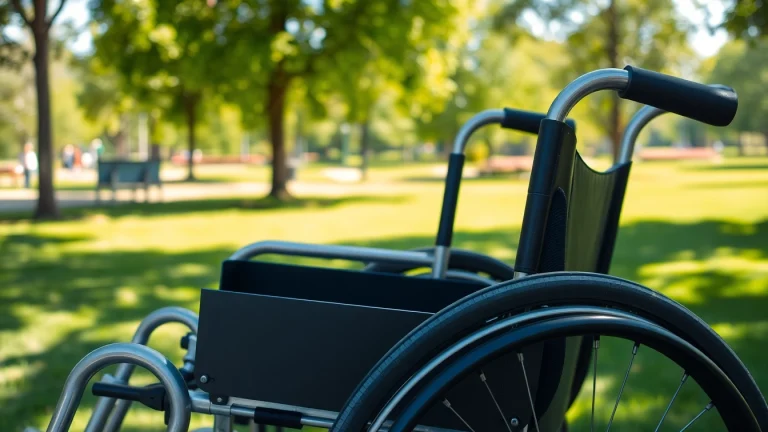
Enhancing Mobility: Your Guide to Choosing the Right Manual Wheelchair
Understanding Manual Wheelchairs
In the realm of mobility aids, manual wheelchairs hold a pivotal position. These devices are designed not only to assist individuals with mobility impairments but also to promote independence and enhance their quality of life. Understanding the nuances of manual wheelchairs equips users and caregivers with the knowledge required to navigate their options effectively.
What is a Manual Wheelchair?
A manual wheelchair is a type of wheelchair that is propelled by the user or an assistant. Unlike powered wheelchairs, which rely on batteries and motors, manual wheelchairs offer a more traditional approach, providing the user with direct control over their movement. These wheelchairs generally consist of a seat, backrest, footrests, and wheels. They can be highly customizable to suit individual needs and lifestyle requirements.
Types of Manual Wheelchairs
Manual wheelchairs come in various types, each designed to meet specific needs:
- Standard Manual Wheelchairs: These are basic models suitable for general use, often affordable but may lack advanced features.
- Lightweight Wheelchairs: Lightweight models are easier to maneuver and transport, often made from materials like aluminum or titanium.
- Transport Wheelchairs: Designed for short-term use, transport wheelchairs are lightweight and intended to be pushed by a caregiver.
- Reclining Wheelchairs: These models allow users to recline the seat for added comfort, which is vital for those with pressure sores or specific medical conditions.
- Sports Wheelchairs: Built for athletic activities, these wheelchairs are designed to be agile, durable, and sport-specific, allowing users to engage in basketball, tennis, and other sports.
Key Features to Consider
When choosing a manual wheelchair, several key features should be considered:
- Seat Width and Depth: Proper fit is crucial for comfort and safety; a well-fitted seat prevents pressure sores and promotes better posture.
- Weight: The lighter the wheelchair, the easier it is to propel and transport. A lightweight wheelchair can significantly enhance mobility without excessive strain.
- Wheel Type: Consideration of wheel size is essential; larger rear wheels enable better outdoor mobility, while smaller wheels are suitable for indoor environments.
- Foldability: If transport is a priority, look for models that can be easily folded for storage in vehicles or tight spaces.
Benefits of Using a Manual Wheelchair
The choice to use a manual wheelchair offers a host of benefits that significantly impact the lives of users.
Improved Mobility and Independence
One of the primary advantages of manual wheelchairs is the level of independence they provide. By enabling users to navigate their environment without relying solely on others, these wheelchairs enhance personal autonomy. With practice, many users develop the strength and coordination needed to propel their chair effectively over various terrains.
Cost-Effectiveness Compared to Powered Options
Manual wheelchairs are often more affordable than their powered counterparts. Not only do they have lower upfront costs, but they also incur fewer maintenance and repair costs since they do not rely on batteries or electrical components. This cost-efficiency makes manual wheelchairs an attractive option for many individuals and families.
Health Benefits and Physical Activity
Using a manual wheelchair can contribute positively to physical health. The act of propelling a wheelchair offers users a form of exercise, promoting upper body strength and stamina. Additionally, the engagement in daily physical activity has numerous cardiovascular benefits, helping to maintain overall health and well-being.
Choosing the Right Manual Wheelchair
Selecting the appropriate manual wheelchair is a personalized process that demands consideration of both individual needs and preferences. Careful assessment will lead to a more satisfying experience for users.
Assessing Your Needs and Lifestyle
Understanding the specific needs of the user is crucial in selecting a manual wheelchair. Factors such as the user’s physical condition, lifestyle, and daily routine should guide the decision-making process. For example, someone who spends a lot of time outdoors may benefit from a wheelchair with larger rear wheels and a sturdy frame.
Size and Fit Considerations
Proper sizing is paramount. An ill-fitting wheelchair can lead to discomfort, difficulty in maneuvering, and health issues such as pressure sores. A fitting session with a healthcare professional can ensure that the selected chair addresses the user’s dimensions and support needs effectively.
Understanding Weight Capacity and Materials
Each wheelchair model has a specified weight capacity according to its construction materials. Users must consider their weight alongside any additional loads such as backpacks or medical supplies. Materials such as aluminum are lightweight yet sturdy, while steel is more robust but heavier. Balance is key when choosing the right material based on mobility needs.
Maintenance and Care Tips for Manual Wheelchairs
Like any mobility aid, manual wheelchairs require regular maintenance to ensure safety and functionality. Proper care can extend the lifespan of the wheelchair.
Regular Inspection and Upkeep
Regular inspections should include checks on tire pressure, wheel alignment, and the condition of brakes. Ensuring that tires are adequately inflated not only improves mobility but also enhances safety. Regular cleaning of the frame and seat can prevent wear and prolong longevity.
Common Repairs You Can Handle
Many minor repairs can be undertaken by the user or caregivers. For instance, fixing a flat tire, replacing seat cushions, or adjusting footrests are manageable and can save time and money. It is beneficial to have a basic toolkit available for wheelchairs, equipped with the necessary wrenches, screwdrivers, and tire levers.
Long-Term Care Strategies
Long-term care involves routine check-ups and establishing a maintenance schedule. It’s advisable to take the wheelchair to a professional for comprehensive inspections at least once a year to assess wear and tear that may not be visibly apparent but could compromise safety and performance.
Real-Life Experiences and Testimonials
Hearing from those who use manual wheelchairs can provide invaluable insights. Personal stories and expert opinions can significantly inform potential users and caregivers.
Personal Stories from Manual Wheelchair Users
Consider the testimony of Sarah, a user from Melbourne who shares how a manual wheelchair transformed her daily life. “I initially felt limited by my condition, but the manual wheelchair gave me the freedom to navigate my community. It’s empowering to know I can move independently again,” she reflects. Her experience emphasizes how manual wheelchairs can reinstate a degree of freedom and confidence.
Expert Opinions on Choosing Manual Wheelchairs
Healthcare professionals often advocate for the importance of personalized choice when it comes to manual wheelchairs. Occupational therapists frequently highlight how the right wheelchair can enhance users’ physical capabilities, adding that fitting and adjustments should be tailored meticulously to the individual. This input can be critical in decision-making.
Community Involvement and Support Resources
Engaging with community resources can further enrich the manual wheelchair experience. Organizations offer support through both informational resources and community engagement, creating networks that foster shared experiences and advice. Participation in support groups can also provide users additional confidence and inspiration as they share their journeys.


